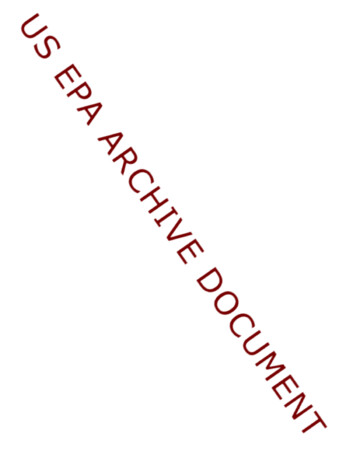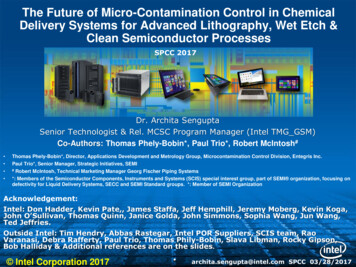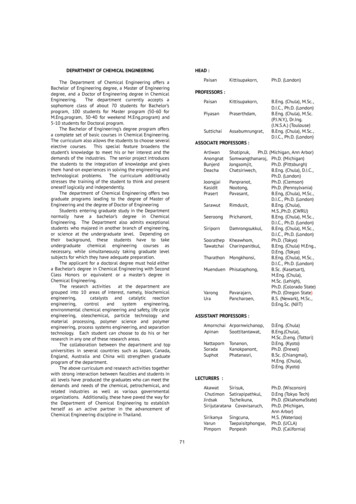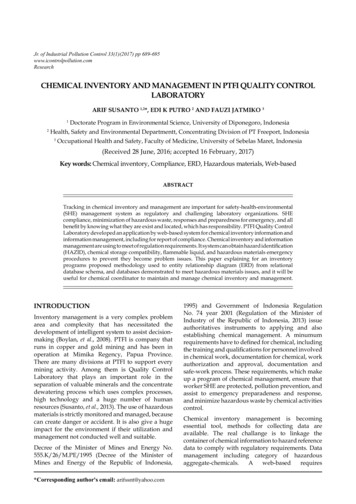
Transcription
To:Brad Manning, Ken Brown (UNH)CC:Jill Kauffman JohnsonFrom: Tom Votta, Freda FungDate: December 3, 2003Re:DRAFT UNH Case StudyChemical Environmental Management System (CEMS) atUniversity of New HampshireI.BackgroundThis case study documents the chemical management system of the University of New Hampshire(UNH). It intends to illustrate a "best practice" of chemical management in the university andresearch setting. This memo provides a description of the chemical management system at UNH,discusses costs for setting up the system, and examines critical factors for the success of the systemto improve chemical management at UNH.CollectionTredis atmpo ensa t /lyIntdis ernatrib lutionApus plice ation/InventorDeliveryProcurementFigure 1: The Chemical Management LifecycleEHS, monitoring and reportingLiabilityEmergency preparednessWe will use the chemical lifecycle (Figure 1) to characterize the current chemical managementsystem of UNH. The stages of the lifecycle show different activities that are required to use achemical. In the educational setting, we see a strong focus on procurement, inventory, use,disposal, EH&S and emergency preparedness.Boston Office: (at Tellus Institute)11 Arlington Street, Boston MA 02116 USATel: 1.617.266.5400 Fax: 1.617.266.8303www.chemicalstrategies.orgelectronic transmission
Founded in 1866, UNH is a public university serving 10,800 undergraduate students and 2,000graduate students. Located in the rural town of Durham, NH, UNH comprises the colleges ofLiberal Arts, Engineering and Physical Sciences, Life Sciences and Agriculture, the School ofHealth and Human Services, the Whittemore School of Business and Economics, and theThompson School of Applied Science. UNH also has an urban commuter campus at Manchester,NH.Prior to the establishment of a centralized chemical management system, UNH had no designatedunit responsible for tracking what chemicals were stored on the campus, or overseeing howchemicals were being managed. Most chemical users (such as researchers and facility maintenancestaff) purchased their own chemicals, and they were responsible for proper management of theirown chemicals.UNH's initiative to develop an extensive chemical management system stemmed fromenforcement actions. In 1997, a three-day U.S. Environmental Protection Agency (EPA) inspectionfound violations of the Resource Conservation and Recovery Act (RCRA) at various UNHlaboratories and storage facilities. In a consent agreement with EPA, UNH agreed to pay a fine of 49,000 and implement a web-based information system – estimated to cost about 180,000 - tomanage chemicals the university uses and stores. In addition, the university promised todocument that it has trained personnel in hazardous waste management and has performedinternal inspections in all areas where hazardous wastes are stored.UNH’s efforts to establish a chemical management system started out by evaluating existingchemical inventories. The Environmental, Health and Safety Department (EH&S) conducted thefirst campus-wide chemical inventory audit in 1998 to document all existing chemicals stored onthe campus. More than 42,000 chemical containers were identified, each container was taggedwith a barcode, and all chemical records were inputted in a Microsoft Access file. To reach thegoal of eliminating mercury from the campus, EHS urged owners of chemicals that containmercury to dispose of or recycle the chemicals.While conducting the first audit, EH&S was also looking for an off-the-shelf chemical inventorymanagement software product to facilitate tracking and management of chemical inventoryinformation in the long run. After comparing the functionalities of inventory managementsystems that were available at that time, UNH purchased an information software, ChIM, from asoftware company, Vertere, in the fall of 1998. The ChIM software was chosen because itpossessed functionalities that UNH considered best fit its needs. For instance, Vertere has licensedwith Sigma Aldrich and Fisher Scientific to have catalogs of chemicals from these two suppliersbuilt into ChiM. This function greatly saved the labor for creating chemical records – when ChiMusers create a new chemical record, they only need to type in a product number and all relatedinformation of the corresponding chemical will be automatically filled in.In addition, thesoftware has a built-in auto-tag generation function for creating a unique identification number foreach container that allows users to easily print out the corresponding barcode tag, or if users havetheir own bar-code tags, the system allows users to scan the barcode of each container into thedatabase. The chemical records from the first audit, in Access format, were then imported into theChiM database (with a fee) after the software was purchased.After the first audit, EH&S set up a new procedure to track newly purchased chemicals. Everytime a researcher purchased a new chemical, he/she would need to tag a bar code on the chemicalChemical Strategies Partnership pg. 2 of 18
container – a number of barcode labels were distributed to each laboratory – and submit astandard paper form to EH&S with the barcode number and the respective chemical information(e.g. chemical owner, chemical name, storage location, etc). Based on the paper forms, EH&Sentered chemical records into the centralized database which could only be accessed from the fourcomputers in the EH&S office that had ChiM installed.In 1999, a second campus-wide audit was conducted to verify the centralized chemical inventoryrecords, and a 20% discrepancy was identified. The discrepancy came from chemicals that hadbeen removed or disposed after the first audit, as well as newly purchased chemicals that had notbeen recorded in the centralized database. It was believed that new chemical purchases wereunderreported because the system for reporting newly purchased chemicals using paper forms didnot get buy-in from researchers. Since researchers could not access the centralized database,unless they kept copies of the reporting forms, it was difficult for them to see any results of theirefforts and recognize the value of maintaining an up-to-date chemical inventory.Findings from the second audit highlighted the limitations of ChiM to provide a campus-wideaccessible information system. Since ChiM is not a web-based system, the only way to allow allchemical users have access to chemical inventory records is to install the software in eachindividual’s computer. However, an annual site license fee was required for installation in eachcomputer where it is used, therefore, the use of ChIM campus-wide would entail high costs. Eventhough at that time Vertere had plans to upgrade ChiM to a web-based system, there was nodefinite timeframe for such an upgrade. With the intention to minimize costs in the long run andfulfill UNH’s specific needs, UNH decided to develop in-house a web-based chemical informationtracking software and named it the Chemical Environmental Management System (CEMS).The information tracking software was jointly developed by EH&S and the Research ComputingCenter (RCC) at UNH. Programming of the CEMS started in the winter of 2000. The first versionof the CEMS was piloted in a marine biology laboratory, and laboratories of the Department ofMicrobiology in January 2001. At the same time, two centralized receiving areas - the ChemistryStockroom and the EH&S Chemical Transfer Station - were set up, where newly purchasedchemicals are received and tagged with barcodes, and new chemical inventory records are createdin the centralized inventory database. A campus wide education and outreach program waslaunched in parallel to educate chemical users on how to use CEMS (e.g. how users can accesstheir own chemical inventory records, and how to search for surplus chemicals), and inform themof the new receiving arrangement, as well as their responsibilities under the new arrangement.Receiving feedbacks from the pilot laboratories and other chemical users, RCC upgraded theCEMS and launched a revised version campus-wide in the fall of 2001.1 CEMS now provides aweb interface where chemical users, EH&S staff, and local Fire and Police Departments can log onto their own customized homepages. For instance, homepages of all chemical users provide directlinks to run queries on the existing chemical inventory. The information system also allows usersto post a request for hazardous waste disposal pick-up, or to designate surplus chemicals so thatother users know when searching the chemical inventory. Homepages of EH&S staff and local1To further the efforts to eliminate use of mercury, EHS initiated a thermometer exchange program, through whichEH&S would pay for the replacement of mercury-containing thermometers with non-mercury thermometers. Thisprogram was rolled out at the same time as the introduction of CEMS.Chemical Strategies Partnership pg. 3 of 18
Fire and Police Departments provide additional links to view special information on classes ofchemicals with particular environmental or explosive characteristics.The goals of the chemical management system at UNH are to:oBe in compliance with environmental legislationoEnsure that chemicals are not stored indefinitely on campusoOptimize chemical purchases, and reduce chemical use in teaching laboratories, whereappropriate.oImprove laboratory safety and emergency preparednessoIdentify hazardous materials on campus and possible non-hazardous substitutionsThe system is now implemented campus-wide, supporting 67 departments, 320 chemical usersand 255 laboratory associates. The system also keeps chemical inventory records and door signs ofnon-educational facilities, such as the vehicle maintenance garage, the greenhouse pesticide andfertilizer storage areas, storage areas for facility maintenance supplies and custodial cleaningsupplies.In addition to software development, RCC performs ongoing maintenance, troubleshooting andupgrading of the system. For instance, RCC is developing two new modules for radioactive andbiological inventories. In addition, UNH allows other universities to license the CEMS software,with RCC acting as the Application Service Provider to maintain the software for the licensees.2RCC, therefore, continues to develop new features to cater for the needs of licensees.II.Chemical Management Processes at UNHAn overview of the current chemical management system at UNH is presented in Figure 2. Asshown in the figure, the CEMS system tracks chemicals from the time they arrive at the campus tothe point of disposal. The following section summarizes how UNH manage chemicals at eachchemical lifecycle stage under the current chemical management system.1. ProcurementMost researchers and university staff purchase their own chemicals. Chemicals are mainlyacquired via two pathways: by individual purchasing cards (credit cards or p-cards) or throughorders through the Business Service Centers. Researchers are free to choose whichever chemicalsuppliers they prefer, subject to their research and teaching needs. Chemical information isentered into the CEMS system only when the chemical is delivered to the campus (see next section"Inventory"). Thus the CEMS only contains information of chemicals currently on-site and doesnot contain information on the total dollar value of chemical purchases.3 Additionally, since the2Brown University is the first university that has bought the CEMS license for managing its chemical inventory. In addition,University of Massachusetts – Amherst has also signed on to use CEMS. They are currently undergoing their first chemicalinventory audit which mainly focuses on Morrill Hall, the primary science building on campus. More information about CEMScan be found at: http://www.cems-info.sr.unh.edu/.3The system originally planned to create an interface connecting to the procurement stage of chemical suppliers, and organizedmeetings with the three main chemical suppliers -Sigma Aldrich, Fisher Scientific and VWR International – to discuss theChemical Strategies Partnership pg. 4 of 18
system was designed as a hazardous material tracking system, rather than an accounting system, itdoes not track the proportion of chemicals purchased through these two pathways. However, it isbelieved that there are advantages for researchers to purchase chemicals through the use ofpurchasing cards.4There are in general no restrictions on chemical purchases, except for prohibited chemicals – suchas Dimethyl mercury – and chemicals that contain radionuclides, which require approval fromEH&S prior to purchasing.5 Even though requisition of chemicals does not go through the CEMS,EH&S encourages both chemical users and the business center to look online for surplus chemicalsbefore placing an order.According to the CEMS database, about 65% of chemicals are ordered through three mainsuppliers - Sigma Aldrich, VWR International (VWR), and Fisher Scientific. Each of these mainsuppliers acts as both suppliers of chemicals and distributors.62. InventoryThe CEMS information software currently records an inventory of 49,883 chemical containers.7Inventory records of newly acquired chemicals are created at the centralized receiving locations,where EH&S staff or other designated parties are responsible to receive chemicals, tag chemicalcontainers with bar codes, and input chemical information– such as CAS number, chemical owner,storage location, vendor, product number, container size, unit of measure, and type of container into the centralized inventory database. After tagging barcodes, EH&S staff deliver chemicals toindividual users or departments. EH&S requires that all chemicals received at the ChemicalTransfer Station be delivered to chemical users the same day as arrival.Chemicals acquired for non-laboratory use (e.g. custodial and facility maintenance chemicals) arenot received at the centralized receiving locations. The inventory records of these chemicals arekept up-to-date through periodic inventory audits undertaken by EH&S.feasibility. RCC finally decided that it would be too difficult to create such an interface in CEMS because the ordering webpages of some suppliers are linked to their own inventory database, and so cannot be accessed directly through CEMS. Also,many vendors do not have web sites for ordering chemicals.4By ordering chemical using p-cards, researchers can better manage grant funding by dedicating a p-card to a particular grant, andobtaining multiple cards for multiple grants. In addition, researchers place orders directly with suppliers and can check anyorder themselves.5 Dimethyl mercury is prohibited at UNH campus. Chemicals containing a radionuclide must be approved and ordered by the UNHRadiation Safety Officer.6Information extracted from the CEMS database, as of January 2, 2003. Since the database provides information on manufacturersand not suppliers, it was assumed that the suppliers and manufacturers have exclusive contracts as follows:VWR International - Distributor for Aldon, Alfa Aesar, BDH, Burdick & Jackson, EM Science, ICN Bio, JT Baker,Mallinckrodt, Pierce, Ricca, Shelton, and Ultra;Sigma Aldrich – Distributor for Sigma, Aldrich, Fluka, and Supelco brands.Fisher Scientific – Distributor of its own brand name product, Fisher Scientific as well as Acros Chemicals and other secondarymanufactures.7According to the CEMS inventory database, as of July 21, 2003.Chemical Strategies Partnership pg. 5 of 18
ChemicalPurchase(throughBusinessService Centeror credit card)Delivery(bySuppliers)Receiving(at thecentralizedreceivingplaces)Use(byresearchersor lectionanddisposalEH&SEmergencyPreparednessReuse ofsurpluschemicalsChemicaldeliveries toChemicalTransferStation orChemistryStockroomEHS staffbarcodesanddeliverschemicals tochemical usersChemicalsstoredin reseachandeducationalfacilities1. Report surpluschemicals2. Request removalof haz. waste3. Update chemicalowners' / labassociates'personal profileUsers handledisposal ofnon-haz chemicalsUseEH&S handleshazardouschemical waste1. DownloadMSDS2. Searchsurpluschemicalsenter chemicalinfo intoCEMSCEMS InformationTracking Software- developed andmaintainedby RCC1. Haz. wasteremoval request2. Chemical owners'/lab associates'contacts, chemicalstorage infoEH&S tomaintain theCEMS software1. Maintain MSDS2. Spot check, manualinventory updateNotes:Chemical flowInformation flowFire Dept. accesseschemical storageinformationFigure 2: University of New Hampshire - Chemical Environmental Management SystemChemical Strategies Partnership pg. 6 of 18
All chemicals ordered by the Chemistry Department are currently received at the ChemistryStockroom. The Chemistry Stockroom also holds stock of selected chemicals that are dispensed tochemical users of other departments. The Chemistry Stockroom now holds 523 chemicalcontainers (as of October 2003), i.e. about 1% of the total inventory.8Chemicals ordered by the staff of other departments are arranged to be delivered to the ChemicalTransfer Station. In order to avoid chemical orders from circumventing the centralized receivingsystem, UNH established an agreement with the three main suppliers to deliver all chemicals except those ordered by departments in Parsons Hall - to the Chemical Transfer Station. UNH alsocommunicates regularly with UPS, FedEx and other shipping companies to educate them aboutsending all parcels containing chemicals to the Chemical Transfer Station.9While EH&S does not have a regular audit schedule to systematically verify consistency of theinventory data with the actual inventories in each laboratory, it has set up a guideline to visit atleast 10% of laboratories annually to identify chemicals that have circumvented the receivingsystem and have not been barcoded. These audits are conducted at laboratories that show“questionably” low disposal quantity compared to inventory, or are performed when: A researcher moves to another laboratory, or leaves the university, and all chemicals in thelaboratory need to be either scanned out of the CEMS database entirely, or rescanned into anew location. This happens about seven to eight times in one academic year. A chemical owner requests EH&S to re-inventory his/her laboratory due to changes inpersonnel or graduate students. A laboratory or building undergoes significant remodeling or upgrading and all chemicalsstored inside need to be verified in order to perform a hazard assessment prior toconstruction/renovation.The inventory database can be searched and viewed by all chemical users, EH&S and local Fireand Police Departments using the web-based CEMS. For biological agents, or chemicals that canbe used to make potentially dangerous or illegal products, chemical owners could request to hidetheir inventory from being searched by other users. The hidden items, however, could still beviewed by the local Fire Department, EH&S, and the owners themselves.3. UseChemical use for education and research purposes is characterized by a high diversity and lowvolume pattern. The CEMS does not track consumption of chemicals, just their containers. A8The Chemistry Stockroom has conducted a clean out in January 2003 to identify and dispose chemicals that are no longer neededby researchers. Before the cleanout, the stockroom had over 4,000 chemical containers.9Despite best efforts to educate chemical users on the central receiving arrangement, some researchers still provide their ownlaboratory address when ordering chemicals because they have failed to separate the chemical part of the order from the labsupplies part. Furthermore, drivers of UPS and FedEx sometimes change and thus some chemicals are being sent to theresearchers directly. Although it is hard to quantify, it is believed that up to 5% of newly purchased chemicals could havebypassed the two centralized receiving locations.Chemical Strategies Partnership pg. 7 of 18
container appears to be full in the database until its owner declares it empty through the directlinks on the chemical owner’s homepage. In addition, the CEMS software allows chemical users todesignate unneeded chemicals that can be made available to other users free-of-charge. If aresearcher wants to acquire a new chemical, he/she can check the surplus chemical list throughCEMS, obtain the contact information of the chemical owner if the chemical needed is found, andcontact the chemical owner directly for details about the chemical, such as purity and age.4. DisposalDisposal of non-hazardous chemicals is not subject to any regulatory requirement, and therefore istypically handled by chemical users. But EH&S encourages chemical users to remove or obliteratebar-code labels prior to disposal, and report these containers empty through CEMS so that EH&Sknows that these chemicals no longer exist on the campus. Hazardous waste chemicals, however,must be taken care of by EH&S. Chemical users can request a pick-up service through their ownCEMS homepages. After receiving a request, the Hazardous Waste Coordinator of EH&S willcollect the hazardous waste chemical for off-site treatment by their sub-contractor.Before implementing CEMS, all hazardous waste disposal records were kept on paper copies withthe shipping manifests. Now all hazardous waste pick-up records are kept in the database andEH&S and researchers can easily search the disposal records by the type of waste stream, the dateof pick-up, name of waste generator, and department. This enables EH&S to easily identify keywaste generators and target education programs on waste reduction.To ensure that chemicals will not stay indefinitely on the shelf, a default 3-year evaluation date isset in the CEMS software. Periodically, the CEMS software will check the date of entry of eachchemical, and if a chemical is detected to have stayed in the campus for 3 years, an email will besent automatically to alert EH&S, who will then request the chemical owner of the long-stayingchemical to consider disposal or listing that chemical on the surplus chemical list.10 By referencingto the date of entry, the 3-year evaluation date ensures that long-staying chemicals are beingtracked and managed properly, while keeping data entry for CEMS as simple as possible.5. EH&S and Emergency PreparednessSeveral features of the CEMS information software are designed to improve health and safety inlaboratories and facilitate compliance reporting and emergency preparedness:i.10Regulatory compliance module. The module for regulatory compliance automatically prompts tonotify the responsible people of satellite accumulation areas (SAAs) via email when aninspection is due, and provides a direct link of the regulatory module for creating SAAmonthly inspection report in the reminder email. Currently, the CEMS keeps a database withall inspection reports of SAA. The CEMS regulatory module also has similar functions tofacilitate reporting for above ground storage tanks (AST) and small quantity generators (SQG),and EH&S is planning to include the chemical fume hood inspection reports and the fireextinguisher reports in the CEMS database.Note that the actual shelf-life of chemicals is not stored in the CEMS, since management of chemicals with short shelflife is considered the responsibility of chemical users.Chemical Strategies Partnership pg. 8 of 18
Furthermore, preparation of the University’s Tier II report, which had been based on paperrecords of hazardous chemical inventory, has been progressively easier with a built-in functionof CEMS.ii. Door signs. The CEMS stores the hazard information found on the door signs for alllaboratories or rooms that have storage of chemicals. The door sign of each room displays thenature of chemicals stored and contact information of chemical owners or laboratory associatesin case of emergency. To ensure that laboratory door signs are kept accurate and up-to-date,periodically, CEMS generates emails to remind chemical users to review and updateinformation displayed on the door sign.iii. MSDS and chemical fact sheets. The CEMS database currently has electronic version of MSDSand chemical fact sheets for more than 80% of the chemicals in the inventory. For chemicalswith only print copies of MSDSs or chemical fact sheets, chemical users are required to keepthe print copies at places where chemicals are used or stored. An electronic MSDS can beviewed on-line by anyone on campus, and it is also provided as a direct link to items residingin the chemical inventory for the benefit of chemical owners, as well as emergency responders.When a new chemical is purchased, EH&S is responsible for requesting new MSDS or thechemical fact sheet from its vendor and upload it to the system. Ultimately, EH&S aims tohave MSDS sheets for all chemicals on the campus.iv. Allow local Fire and Police Departments access of database. Each month the local fire and policedepartments are provided an updated CD ROM of CEMS information. If an accident occurs,Fire and Police Departments can bring the CD on their patrol cars and quickly check the CDROM using labtops (provided by the University) in their cars to assess the potential hazard of aspecific laboratory or room before arriving at the site. The CD contains the entire chemicalinventory - sorted by location and hazard - with links to MSDS of each chemicals stored, andthe emergency door signs. The Fire and Police Departments also have 24-hour on-line access tothe latest information on chemical inventory. Additionally, the latest version of CEMS allowsthe emergency responders to download the entire inventory/MSDS/door signs onto a CD orzip file at will. This improvement allows them to have the most up-to-date information in theevent of a real emergency.v. Particularly hazardous chemicals. The UNH Chemical Safety Committee has established a list ofparticularly hazardous chemicals that require special attention on the UNH campus. To alertusers of the hazardous nature of these chemicals, whenever a particularly hazardous chemicalis displayed on CEMS, the type of hazard is shown next to the chemical name and highlightedin red (e.g. If a chemical is a carcinogen, the word “carcinogenic” would be displayed in rednext to the chemical name). These chemicals will also be listed on the top of the inventory of alaboratory when it is viewed by Fire and Police Departments through the EmergencyResponders module.vi. Hiding a chemical from view. For security reasons, the CEMS allows chemical users to 'hide' thelocation and type of a chemical that could be used to make potentially dangerous or illegalproducts, or if the owner does not want to share the chemical information with the rest of theUNH research community, with the approval from EH&S. Only the Durham Fire Department,EH&S and the chemical owners themselves can view the records of hidden chemicals.Chemical Strategies Partnership pg. 9 of 18
vii. Posting of training and upcoming events. The homepage of individual chemical users contains a"memos" table, which conveys up-to-date information related to the CEMS, such as scheduledtraining and vendor visits.III.Summary of Costs and Resources for Developing and Maintaining ChemicalManagement at UNHThe CEMS is part of a broader effort toincrease EH&S capacity at UNH. Since 1997,the EH&S team has expanded from three toeight full-time technical staff (see Box 1). Inthis cost analysis, we include labor andcapital costs that are dedicated to the designand implementation of the chemicalmanagement system, which cover thechemical life cycle stages of inventory,delivery, use, EHS and emergencypreparedness (see Figure 1). We have alsoincluded the total costs for managinghazardous chemical waste disposal.Box 1. List of EH&S Personnel at UNHBefore 1997After 1997DirectorDirectorHazardous WasteCoordinatorHazardous Waste CoordinatorHazardous Material CoordinatorChemical SafetyOfficerEngineering TechnicianEnvironmental Health and SafetySpecialistChemical and Biological SafetyCoordinatorOccupational Health & SafetyCoordinatorWe have broken down the cost forRadiation Safety Officerdeveloping and maintaining the chemicalmanagement system into two categories: 1)one-time initial development cost; and 2)ongoing maintenance costs. The one-time initial development cost is defined to be the labor andcapital costs for designing and setting up the new chemical management system – includingresources for undertaking inventory audits, purchase of ChiM, and programming of the originalversion of CEMS that was released in January 2001. The ongoing maintenance cost refers to theannual cost required for upgrading and maintaining CEMS, the operation of centralized receivingstations, education and outreach, communication with emergency responders and researchers, etc.A total initial development cost of 322,000 was estimated for the groundwork for establishing thechemical management system, and developing the original version of CEMS.11 The cost covers:1. The EH&S labor cost for conducting the two inventory audits and assisting in the design of thenew chemical management system, and2. Capital costs for purchasing ChiM3. The RCC labor cost to design the original version of CEMS software4. Capital costs for equipment to operate CEMS11Note that the original version only possessed some basic functions such as inventory search, reporting and searching of surpluschemicals, posting request for chemical waste disposal. The CEMS software was continuously enhanced and improved after therelease of the original version, and the labor costs for upgrading the software are counted under on-going maintenance andenhancement.Chemical Strategies Partnership pg. 10 of18
Ongoing CEMS maintenance and management involves 1.15 FTE EH&S staff (two-third of theHazardous Material Coordinator’s time and 40% of the Engineering Technician’s time), a full-timeRCC software designer, and a part-time student f
This case study documents the chemical management system of the University of New Hampshire (UNH). . EH&S was also looking for an off-the-shelf chemical inventory management software product to facilitate tracking and management of chemical inventory information in the long run. After comparing the functionalities of inventory management










